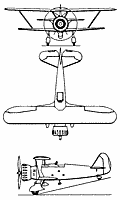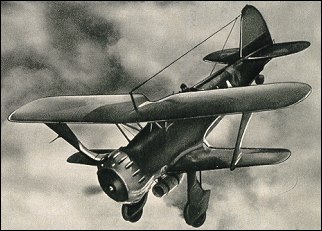|
| Designed as an interim dive bomber until an aircraft of the Junkers Ju 87 class was available for squadron service, the prototype single-seat Hs 123 biplane first flew in 1935. Hs 123A-1 production aircraft entered Luftwaffe service from October of that year. In the following year a number were evaluated in Spain as an element of the Nationalist forces fighting in the Civil War. These proved particularly successful for ground attack. With the out-break of World War II many Hs 123 were still in first-line service with the Luftwaffe as ground-attack aircraft and these participated in the campaigns against Poland, Belgium, France and then Russia - where they continued to operate until the middle of 1944.

| MODEL | Hs 123A-1 |
| CREW | 1 |
| ENGINE | 1 x BMW 132Dc, 656kW |
| WEIGHTS |
| Take-off weight | 2215 kg | 4883 lb |
| Empty weight | 1500 kg | 3307 lb |
| DIMENSIONS |
| Wingspan | 10.5/8.0 m | 34 ft 5 in / 26 ft 3 in |
| Length | 8.33 m | 27 ft 4 in |
| Height | 3.2 m | 11 ft 6 in |
| Wing area | 24.85 m2 | 267.48 sq ft |
| PERFORMANCE |
| Ceiling | 9000 m | 29550 ft |
| Range | 855 km | 531 miles |
| ARMAMENT | 2 x 7.92mm machine-guns, 450kg of bombs |
 | A three-view drawing (578 x 962) |
| Dan Borg, e-mail, 26.03.2014 04:02 I am trying to find out if this rugged little biplane was used at all in 1940-1942 by either the Italians or Luftwaffe in raids against Malta or anti-shipping in the Mediterranean. Units? Color schemes / Thanks! reply | | Lorenzo FEDELI, e-mail, 25.03.2014 22:03 I'm interested to see the sure interesting structures of this aircraft.Is it possible? Thanks regards Lorenzo Fedeli reply | | Ross Paxton, e-mail, 26.01.2012 09:51 If anyone knows how many HS-123 were built please let me know. This little plane was not only the most beautiful biplane ever made but was almost indestructable. reply | | beifang, 20.06.2011 12:53 Please E-mail me with the answer. All I know for sure is that the 1 /48 models (now Italeri, but same molds as always) have it wrong with those silly lumps. reply | |
| | wlkriessmann, e-mail, 24.09.2010 03:23 That was a priviledged fun to fly the HS 123-- S13+a46 and HS123- S13+ B12 on Oct 28th and Nov 11th 1939 at Straubing. We were allowed to dive put the diving brakes out and press the button to activate the sirens.wlk reply | | Dan Borg, e-mail, 20.06.2009 05:11 Did the Italians use the Hs 123? In the Malta campaign? reply | | Colin Wright, e-mail, 01.12.2008 05:29 Another bit about the HS-123 is that its ability to operate from primitive airstrips proved so valuable in Russia that it was actually proposed that it be put back into production. However, all the dies had long since been destroyed... reply | | Tom Drennan, e-mail, 01.07.2008 03:38 I believe the dive bomber, especially the German Henschel Hs. 123 is neglected by historians with some interesting details lost and more hard to find. Not the first dive bomber but the first to prove the concept valuable in war.
From the day man realized it was going to be possible to fly airplanes there were discussions of dropping explosives on enemy fortifications. Right away they learned accuracy was going to be a major problem. World War 1 pilots realized aiming the plane at the target in a steep dive would improve accuracy. Dive bombing was tried but the airplanes were not sturdy enough to survive high gee pull outs from terminal velocity dives. The odds of survival were not good, the idea was discouraged until airplanes could be built for the stress. When the war to end all wars ended that good idea along many more faded quickly.
In the middle 1920s, in Nicaragua, the U.S. Marines attempted dive bombing to support troops cut off miles inland out of range of naval gunfire. It seems the airplanes were rugged enough while the bombing was terrible but the threat scared the rebels away. There was new interest in dive bombing.
In 1929 Curtiss offered a modified F8C biplane fighter for dive bombing trials. The navy called the design "O2C-1 Helldiver," and ordered several. US Navy and Marines pilots were quick to learn what they could do with them while asking for improvements that helped engineers design a better war bird. In 1933 Vought entered the competition with their SBU that looked a lot like their very able scout and observation O3U Corsair and their new two seat fighter XF3U. There were a few SBUs still in fleet service when Pearl Harbor was bombed but they were quickly passed to training squadrons. I have not found any information relating to the value of either the O2C or SBU as dive bombers. Evidently they were important in advancing technology but neither was quiet right for the job.
Until the 1929 stock market crash Ernst Udet was making a good living in America mostly as a consultant for war movies and exhibition pilot. It was not unusual for Aircraft companies ask him to show off new war bird designs. He wasn't starving after the stock market crash but had to settle for a modest life style. Germany was beginning to stabilize and rebuild her military forces. There might be a place for him in "The New Germany." Well aware of dive bomber development he managed to get money from Goring to buy at least two, some reports say four, Curtiss O2C dive bombers for show and tell in Germany. It seems the idea thrilled Goring and about that time, 1934 Curtiss announced the first airplane designed from start to finish as a specialized dive bomber, the SBC Helldiver, a two place biplane. Both Goring and Udet knew Germany could do at least as well but the O2Cs would be a good starting point.
The Henschel company built railroad steam engines and wanted to expand the business to build airplanes. They had tried, building a good looking, shoulder wing, single place monoplane. Performance was lacking. No orders were revived. Goring gave the company the job of studying the Curtiss O2C then building a better dive bomber. There was never any intention of relying on the Henschel plane for more than a way to put the company firmly into the aircraft business and provide Germany with an advanced trainer while a much better war bird was designed and produced.
Udet become chief procurement officer for the new Luftwaffe giving the dive-bomber program a high priority. Within 1935 Germany announced three new dive bombers, the Henschel Hs. 123, Blohm and Voss Ha. 137 and Junkers Ju. 87, "Stuka." Henschel had a running start with a working example to improve so there was very little research and development to take up time. They were delivering airplanes while the others were building prototype after prototype.
In 1936 Vought announced their new monoplane dive bomber. The SB2U Vindicator. That plane was a major step forward but came at a time when technology was expanding rapidly, all metal construction, new propellers and engines were making new airplanes obsolete within a few months. The Vought bird was hailed as a modern marvel but dropped into near obscurity by the time the first production models were delivered. Similar events were keeping the new German dive bombers from catching up with technology, prototypes were obsolete before they were finished. It was not worth producing them in significant numbers. Blohm and Voss dropped out of the competition when it was evident Goring and Udet favored Junkers. Henschel didn't have that problem. Goring thought of them as producing advanced trainers not world beating war birds.
The Spanish Civil War provided a proving ground Germany was quick to take advantage of and the little biplane bomber went along to out do all competition. Nobody took the matter seriously, knowing the Ju. 87 had to become superior then they would ret ... reply | | Will Windham, e-mail, 18.06.2008 19:49 Are the louvers in the forward upper fuselage punched in or out? Please E-mail me with the answer. All I know for sure is that the 1 /48 models (now Italeri, but same molds as always) have it wrong with those silly lumps. reply | | STEVEN, e-mail, 26.05.2007 18:41 DID YOU KNOW , THIS PLANE IS STILL ACTIVE IN THE TRAINNING SQUADRON BY MAY 1945. reply |
|
Do you have any comments?
|
| 
COMPANY
PROFILE
All the World's Rotorcraft
|








